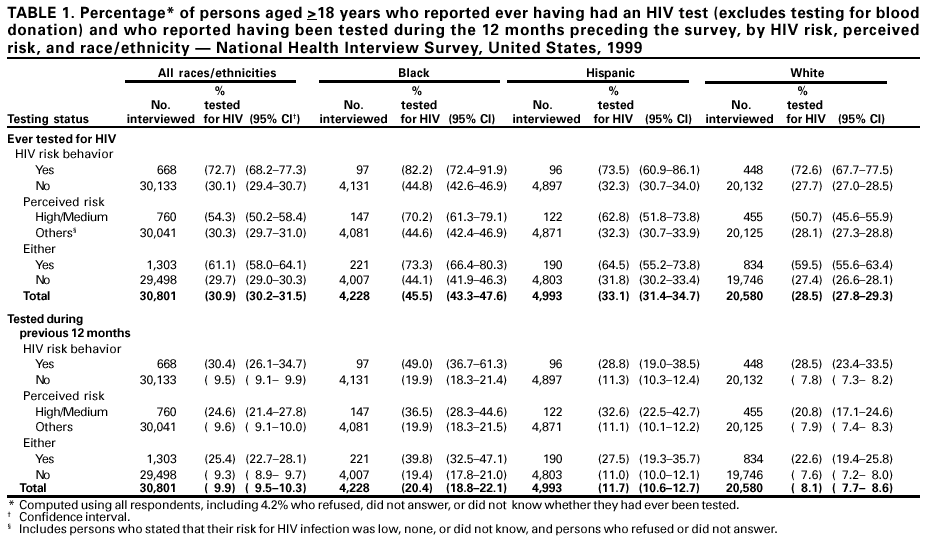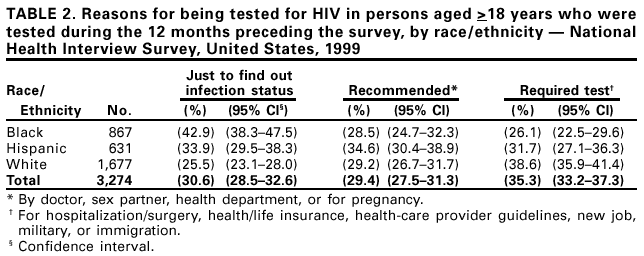 |
|
|
|
|
|
|
|
|
|
|
|
|
|
|
|
|
||||
| ||||||||||
|
|
|
|
HIV Testing Among Racial/Ethnic Minorities --- United States, 1999Human immunodeficiency virus (HIV) infection and acquired immunodeficiency syndrome (AIDS) in the United States disproportionately affect racial/ethnic minority populations, particularly blacks and Hispanics (1). Of the 774,467 AIDS cases reported to CDC during June 1981--December 2000 (2), blacks and Hispanics accounted for 56% of cases, although they represented 25% of the U.S. population during this period. In 2000, the incidence of adult and adolescent AIDS cases per 100,000 population was 74.2 for blacks, 30.4 for Hispanics, and 7.9 for whites (2). HIV counseling and testing services potentially can reduce the risk for infection with HIV and provide referrals to HIV-infected persons for medical care. An estimated 300,000 HIV-infected persons in the United States may be unaware of their HIV serostatus (3). In 2001, CDC introduced the Serostatus Approach to Fighting the Epidemic (SAFE) (3), which focuses on increasing the number of high-risk and infected persons who know their serostatus and helps infected persons receive and maintain appropriate medical care and reduce their risk for transmitting infection. CDC analyzed data from the National Health Interview Survey (NHIS) to determine the rate at which racial/ethnic minorities are getting tested for HIV. This report describes the result of the analysis, which indicates that minority populations are being tested for HIV infection at a high rate; however, a substantial number of persons at risk for HIV have not been tested. Prevention programs should continue to develop innovative methods for counseling and testing at-risk persons. NHIS is an annual, household-based health survey representing the civilian, noninstitutionalized U.S. population aged >18 years (4). The 1999 NHIS data are based on interviews with 30,801 respondents. The response rate for sample adults was 70%. To determine high-risk behaviors, respondents were asked, "Tell me if any of these statements is true for you: you have hemophilia and have received clotting factor concentrations; you are a man who has had sex with another man at some time since 1980, even one time; you have taken street drugs by needle at any time since 1980; you have traded sex for money or drugs at any time since 1980; since 1980, you are or have been the sex partner of any person who would answer `yes' to any of the items on this card/any of the items I have read." Two of the outcome measures estimated were the percentage of respondents who reported that they had ever been tested for HIV (excluding testing for blood donation) and the percentage who reported that they had been tested during the 12 months preceding the survey. HIV testing rates were computed separately for HIV risk behavior and perceived risk by race/ethnicity. Percentages were computed using all respondents, including 4.2% who refused, did not answer, or did not know if they had ever been tested. Weighting factors were used to compensate for the effects of nonresponses and unequal selection probabilities. Differences among subgroups were assessed using chi-square tests of difference (p<0.05); confidence intervals (CIs) and significance tests were computed using SUDAAN 7.0 to adjust for the effects of the complex survey design. Among 30,801 respondents, 668 (1.9%) (95% CI=1.7%--2.1%) reported at least one of the HIV risk behaviors on the list and were considered at increased risk for infection. Rating their own perceived risk as high, medium, low, or none, 760 (2.3%; [95% CI=2.1%--2.5%]) stated that they had a high or medium chance of becoming infected with HIV. A total of 1,303 respondents were in either of these risk categories (3.9%; [95% CI=3.6%--4.2%]). Among the 30,801 respondents, 43.8% (95% CI=43.1%--44.6%) reported that they had ever been tested for HIV, including testing for blood donation. Blacks were significantly more likely to report previous HIV testing (51.6% [95% CI=49.6%--53.8%]) than Hispanics (39.5% [95% CI=37.7%--41.3%]) or whites (43.6% [95% CI=42.8%--44.4%]). Of all respondents (excluding those tested for blood donation), 30.9% reported having ever been tested for HIV; blacks reported previous testing more frequently (45.5%) than Hispanics (33.1%) or whites (28.5%) (Table 1)*. Among persons who reported any HIV risk behavior, 72.7% reported ever being tested and of persons who perceived a high or medium risk for HIV infection, 54.3% reported ever being tested. Within each racial/ethnic population, more persons who reported any HIV risk behavior were tested than those who did not report any HIV risk behavior, including blacks (82.2%), Hispanics (73.5%), and whites (72.6%). Among those reporting a high or medium perceived risk, past HIV testing was reported more frequently by blacks (70.2%) than Hispanics (62.8%) or whites (50.7%). Testing during the 12 months preceding the survey was reported more frequently by blacks (20.4%) than Hispanics (11.7%) or whites (8.1%) (Table 1). Among persons who reported either HIV risk behavior or high or medium perceived risk, testing during the 12 months preceding the survey was reported more frequently by blacks (39.8%) than Hispanics (27.5%) or whites (22.6%) (Table 1). Although persons with perceived risk or who reported any HIV risk behavior were more likely than others to be tested, a substantial proportion of this group reported never having been tested for HIV: blacks (26.4% [95% CI=19.5%--33.4%]), Hispanics (35.3% [95% CI=26.1%--44.5%]), and whites (38.9% [95% CI=34.9%--42.9%]) representing an estimated 196,000--380,000 blacks, 188,000--455,000 Hispanics, and 1.8--2.4 million whites. More blacks were tested "just to find out their HIV status," while more whites were tested because it was required for insurance, employment, surgery, or military service (Table 2). Hispanics were equally divided between testing just to find out infection status; testing required for hospitalization, insurance, new job, and other application processes; and testing because it was recommended by a health-care provider or sex partner. Reported by: Div of HIV/AIDS Prevention--Surveillance, and Epidemiology, Div of HIV/AIDS Prevention--Intervention, Research, and Support, National Center for HIV, STD and TB Prevention; and an EIS Officer, CDC. Editorial Note:On the basis of data from the 1999 NHIS, 30.9% of adults in the United States have been tested for HIV (excluding testing for blood donation), an increase from 5% in 1987 and 26% in 1995 (5). In the late 1980s, rates of HIV testing (excluding testing for blood donation) were slightly higher for blacks (7%) and Hispanics (7%) than whites (5%) (6). The 1999 data indicated a higher rate of HIV testing among minority populations. However, a substantial number of persons at risk for HIV has never been tested. The findings in this report are subject to at least four limitations. First, self-reported data are subject to recall bias or other reporting errors. Second, highly sensitive information about risk behaviors and perception of risk may be underreported during a face-to-face interview; some persons at high risk may report low risk or low perception of risk. Others may not be fully aware of their partners' current or past high-risk behaviors. Third, there is no information on HIV serostatus of the respondents. Fourth, the survey does not include hospitalized or incarcerated persons. The number of untested, at-risk persons has important public health implications. These data may be useful in evaluating the SAFE strategy and focusing CDC prevention programs. Persons unaware of their HIV-positive status cannot access HIV therapy and may be spreading infection. In a recent study, approximately 35% of men aged 15--22 years who had had sex with men reported not having been tested for HIV infection and many of these men reported having unprotected sexual intercourse (7). At-risk, untested persons are more likely to be tested if they acknowledge risky behaviors, perceive risk for HIV infection, have access to services and culturally sensitive testing programs, and are guaranteed confidentiality (8). In addition, persons are more likely to be tested when HIV counseling and testing are recommended routinely than when testing is based on the person's request (9). HIV testing provides the opportunity for persons to learn their serostatus and to be counseled to adopt risk reduction strategies to prevent getting infected or, if HIV positive, to prevent transmitting the infection to others and to access care. Persons who test HIV positive are more likely to take steps to protect their partners than when they were unaware of their infection (10). Although minority populations with the highest HIV incidence were most likely to be tested, a substantial number of persons at risk, regardless of race/ethnicity, remains untested. Prevention programs should continue to develop innovative methods for counseling and testing at-risk persons and to ensure that seropositive persons are referred for appropriate care. References
*Numbers for other racial/ethnic groups were too small for meaningful analysis. Table 1  Return to top. Table 2  Return to top.
Disclaimer All MMWR HTML versions of articles are electronic conversions from ASCII text into HTML. This conversion may have resulted in character translation or format errors in the HTML version. Users should not rely on this HTML document, but are referred to the electronic PDF version and/or the original MMWR paper copy for the official text, figures, and tables. An original paper copy of this issue can be obtained from the Superintendent of Documents, U.S. Government Printing Office (GPO), Washington, DC 20402-9371; telephone: (202) 512-1800. Contact GPO for current prices. **Questions or messages regarding errors in formatting should be addressed to mmwrq@cdc.gov.Page converted: 11/30/2001 |
|||||||||
This page last reviewed 11/30/2001
|